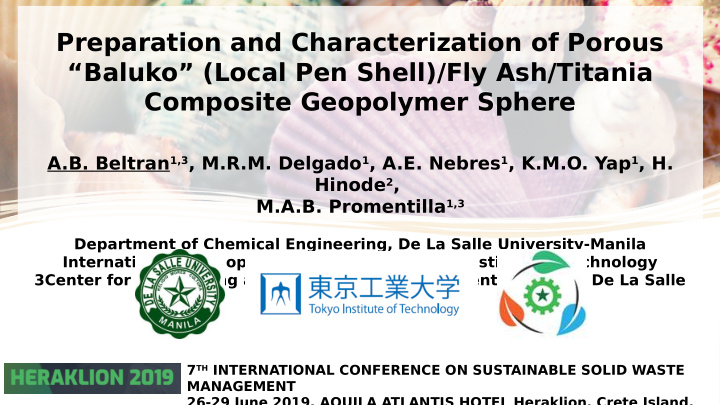



Preparation and Characterization of Porous “Baluko” (Local Pen Shell)/Fly Ash/Titania Composite Geopolymer Sphere A.B. Beltran 1,3 , M.R.M. Delgado 1 , A.E. Nebres 1 , K.M.O. Yap 1 , H. Hinode 2 , M.A.B. Promentilla 1,3 Department of Chemical Engineering, De La Salle University-Manila International Development Engineering, Tokyo Institute of Technology 3Center for Engineering and Sustainable Development Research, De La Salle University 7 TH INTERNATIONAL CONFERENCE ON SUSTAINABLE SOLID WASTE MANAGEMENT 26-29 June 2019, AQUILA ATLANTIS HOTEL Heraklion, Crete Island,
Where is the Philippines?
Manila and DLSU
About Manila and DLSU • 1,100 academic staff (40% full time) • 14,000 undergraduate students • 4,500 graduate students • 11 research centers, 4 research support offices, 1 technology business incubator • 8 colleges, 36 academic departments Br. Andrew Gonzalez College of Education (BAGCED) College of Computer Studies (CCS) College of Law (COL) • Scimago Institution Ranking 714 College of Liberal Arts (CLA) • THE World University Ranking 801+ College of Science (COS) • Assessed at institutional level by AUN QA Ramon V. Del Rosario College of Business • 3000+ Scopus-indexed publications (RVRCOB) • QS World Ranking 801+ School of Economics • QS Asian Ranking 155 Gokongwei College of Engineering (GCOE)
Background of the Study Geopolymer Inorganic polymer- formation of polysialate and polysialate-siloxo networks (Davidovits, 1979) (Barbosal et al., 2000)
Background of the Study Geopolymer Product Engineering Green Materia l https://greenimpactstudenthomes.wordpress.com/ Waste Utilizatio n https://www.uneceppp-icoe.org/news-and-events/news/2016/04/2 1/expert-meeting-on-the-unece-ppp-work-in-waste-disposal-(in cineration-and-utilization)/
Background of the Study Solid Waste Energy Industry Food & Fisheries Industry
Background of the Study Composite Material GEOPOL YMERIZATI ON PHOTOCATALYTIC POROUS GEOPOLYMER SPHERE
Objectives of the Study • To evaluate the potential of “ Baluko ” shell, fly ash, and nanotitania as composite material for the synthesis of porous geopolymer sphere was investigated. • To characterized the composite geopolymer spheres in terms of SEM-EDX, FTIR, XRD, bulk density, open porosity and water absorption capacity. • The evaluate the impact of nanotitana in geopolymer sphere for dye degradation in wastewater.
Methodology
Methodology
Results and Discussion Porous Photocatalytic Geopolymer Sphere Composite Geopolymer Sphere of Fly Ash and Baluko Shell Composite Geopolymer Sphere of Fly Ash, Baluko Shell, and Fly Ash
Results and Discussion Characterization of Geopolymer Sphere: SEM
Results and Discussion Characterization of Geopolymer Sphere: SEM
Results and Discussion Characterization of Geopolymer Sphere: FTIR
Results and Discussion Characterization of Geopolymer Sphere: XRD (a) (b) B0T B5T 0 3 2θ = 20.75°, 26.5°, and 36.4° (quartz) 2θ = 15° and 40° (amorphous material) 2θ = 25.3°, 37.9°, and 48.03° (anatase, a crystalline form of TiO 2 )
Results and Discussion
Conclusion • Coal fly ash and waste “ Baluko ” shell were utilized to produce a porous geopolymer sphere with nanotitania. • It was identified via XRD and FTIR analysis that geopolymerization is still effective even with the Baluko shell replacement to fly ash. • “ Baluko ” shell replacement has no statistically significant effect in bulk density, open porosity and water absorption of the geopolymer sphere. • However, the addition of the shells affected its setting time, allowing the mixture to set at a faster rate with the increasing addition of “ Baluko ”shells. • The methylene blue degradation decreases as the amount of “ Baluko ” shell replacement increases but improved significantly with the addition of nanotitania.
Acknowledgement This study is supported by a grant from Philippine Council for Industry, Energy and Emerging Technology Research and Development (PCIEERD) and Advanced Device and Materials Testing Laboratory (ADMATEL) of the Department of Science and Technology. The researchers also acknowledge the support provided by Hinode Laboratory of Tokyo
Research Group
Thank you very much! Ευχαριστώ Contact Details: Dr. Arnel B. Beltran πολύ! Chemical Engineering Department, De La Salle University - Manila Email: arnel.beltran@dlsu.edu.ph
Recommend
More recommend